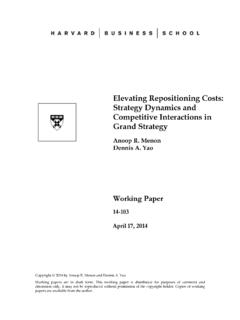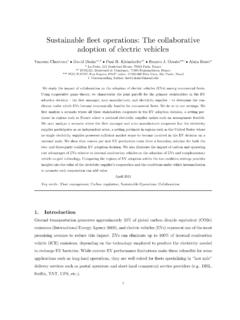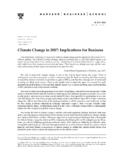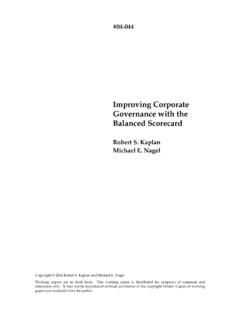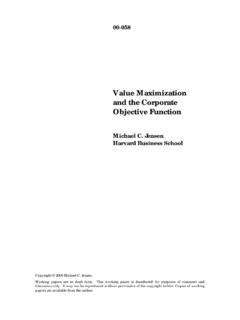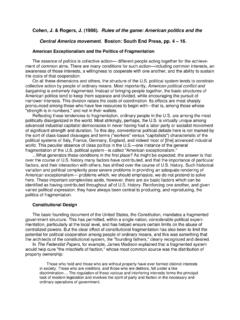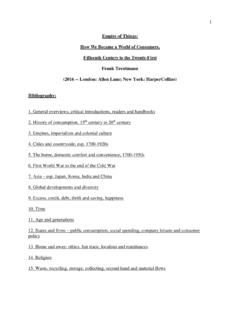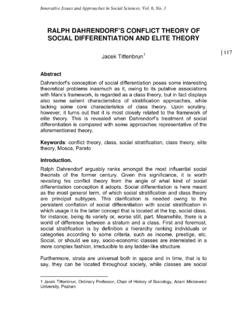Transcription of Cartels and Competition: Neither Markets nor Hierarchies
1 07-011 Copyright 2006 by Jeffrey Fear Working papers are in draft form. This working paper is distributed for purposes of comment and discussion only. It may not be reproduced without permission of the copyright holder. Copies of working papers are available from the author. Cartels and competition : Neither Markets nor Hierarchies Jeffrey Fear 1 Cartels and competition : Neither Markets nor Hierarchies Jeffrey Fear harvard business school Abstract: This article provides an overview on the rise and fall of Cartels since the late 19th century when the modern cartel movement properly arrived with the rise of big business based on scale and scope. The general narrative about Cartels may not be a story of rise and fall, but rise, boom, collapse, revitalization, gradual decline, and then criminalization.
2 Yet, until the 1980s, the global story of big business must be told in conjunction with Cartels rather than without them. They affected technological development, corporate strategy, and organizational change. Viewing Cartels only as a conspiracy against the public short-circuits many important questions and obscures the great variations in objectives, type, and services provided by Cartels . Before 1945 most of the world thought that Cartels brought widespread benefits. Backed by economic might, after 1945 antitrust ideas spread across the world so that now Adam Smith s devastating verdict of them as conspiracies against the public has become the prevailing interpretation. business historians have shown, however, that this consensus about Cartels as conspiracy is historically the exception to the rule, a product of a post-1945 constellation of ideas and events.
3 Cartels are not necessarily the opposite of liberalism and competition , but a variation on them. For better or for worse, they shaped economic and business history since the late 19th century. From the company perspective, joining, managing, or combating Cartels was a major entrepreneurial act. Finally, business historians have shown the varied effects and services provided by Cartels (quality standards, technology transfers, or risk management) that extend beyond the conspiratorial motivation to raise prices. In short, studying Cartels through the lens of conspiracy does a severe injustice to their empirical reality and short-circuits many important theoretical questions. Section 1 offers an array of different cartel types that blur the distinction between legitimate cooperation and illegitimate collusion.
4 It is actually difficult to decide when a cartel is a cartel , what cartel success means, let alone if it acts inefficiently or destructively. Section 2 argues that the voluminous scale and scope of Cartels before 1939, together with lingering cartelization after 1945 in Europe and Japan means that any analysis of entrepreneurship, corporate strategy, and organization, as well as national economic development must incorporate the impact of Cartels . Yet the most neglected area of 2 research is the most important one for business historians. What impact did Cartels have on economic and corporate development (Section 3)? This chapter makes a few broad points. First, Cartels do not abolish competition , but regulate it. The question is not Cartels or competition , but Cartels and competition .
5 Historically, Cartels provided participating firms a range of market -ordering options that antitrust has since foreclosed. Economic analysis works with a stark dichotomy of Markets ( Cartels as distortions) or Hierarchies ( Cartels as incomplete, inefficient internalization). This conceptual straitjacket leads to one of the largest misconceptions about Cartels that they halt competition and innovation. Instead they reshape the rules of the game on which competition rests (similarly Wurm 1993: 291). Second, to fully understand company development and behavior in a cartel -laced world that is, most of the 20th century business historians need to recover those strategic options in between Markets and Hierarchies . If one takes the perspective that joining Cartels is a form of competitive strategy, or at least a cooperative waystation on the road towards future competition , one can explain why Cartels have not damaged economic growth as much as some might expect.
6 Third, if one reframes Cartels as private self-management of an industry, cartel research can fruitfully intersect with studies of government regulation and the burgeoning discussion about business self-regulation. Rightly or wrongly, people conceived Cartels for over a century as a legitimate form of market governance and national industrial policy. Cartels represented at least one way in which contemporaries debated capitalism and attempted to manage its excesses. The cartel question raised important issues about benefits and risks of competition and for whom. To be clear, these cooperative arrangements were by no means benign, mostly second-best forms of competition , and were largely but not exclusively in producers interests. They were, however, sometimes more congruent with the public interest than Smith s claim that they were only an absurd tax created by an order of have generally an interest to deceive and even to oppress the public (Smith [1776] 1976: 278).
7 We need to broaden the discussion of Cartels beyond conspiracy. 3 A Typology of Interfirm Cooperation The classic cartel study by Great Britain s Board of Trade (1944: vi) noted the variety of arrangements is very striking and attests to the ingenuity of industrialists, or at least that of the accountants and lawyers who advise them. It is difficult to generalize about Cartels because they come in such a variety of forms, objectives, and effectiveness. What constitutes a cartel is by no means an easy question. Economists have established a plausible but stylized baseline of theories where Cartels are most likely to appear and endure. George Stigler (1964) famously argued that the acute desire to limit competition was not sufficient to explain when and why collusion occurs; collusion was more difficult than many assumed.
8 Since Cartels created an incentive to cheat, they were inherently instable. The great virtue of this economics literature, reviewed in Levenstein and Suslow (in Grossman 2004) and (2006) more fully, is that it frames questions about inner- cartel behavior more precisely unlike the older literature that relied on individual case studies. This literature tends to find all sorts of ways in which Cartels fail, which, when pushed to the extreme, ironically obviates the need for antitrust policy and cannot explain how or why many Cartels succeed. Levenstein and Suslow found it difficult to generalize about cartel sustainability at all. In their sample, a good number of Cartels lasted longer than ten years; others collapsed quickly. One wheat cartel lasted just one year, but another wheat cartel managed to last 29 years.
9 Japan s cartel movement practically begins with the cotton textile industry after 1880, where the great number of players should have destroyed it; Europeans never developed stable ones. Considering that most capital-intensive firms attempted to form Cartels , the automobile industry never generated one. Innumerable idiosyncratic and history-dependent determinants on top of well-understood structural factors contributed to cartel success, defined as durability. External shocks or demand instability destabilized Cartels as much as cheating. Debora Spar s (1994) analysis of diamond, gold, uranium, and silver Cartels concluded that: At best, structural variables are the necessary but still insufficient precursors of cooperation (p. 218). 4 Although the term cooperation connotes a warm and fuzzy comportment, durable Cartels depended upon constant bargaining, the ability to react flexibly over time, and harsh retaliation.
10 Having a robust collective organization or a dominant player acting as a hegemon (Spar) enhanced Cartels effectiveness, such as in aluminum (Alcoa), electric lamps (General Electric), diamonds (De Beers), or oil (Saudi Arabia). The perils of price wars often helped Cartels cohere. Siegfried Tschierschky (1903), the longtime editor of Germany s leading cartel journal and a cartel director himself, differentiated firms desire to form Cartels (motivation), industry conditions (structure), from their capacity to do so (competence), but practical cartel policies have found numerous ways to confront these difficulties in one or another manner (p. 68). He stressed the psychological willingness, or the ethnological and personal moment.
